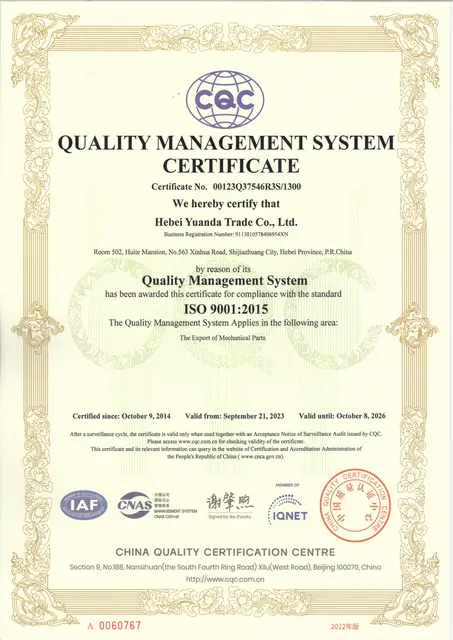Mobile:+86-311-808-126-83
Email:info@ydcastings.com
casting 6061 aluminum
Understanding Casting 6061 Aluminum Properties, Applications, and Benefits
Casting 6061 aluminum is a vital process in the realm of metalworking and manufacturing, renowned for its versatility, strength, and lightweight characteristics. As an alloy primarily composed of aluminum, magnesium, and silicon, 6061 aluminum exhibits exceptional mechanical properties, making it suitable for a plethora of applications in various industries, from aerospace to automotive.
Properties of 6061 Aluminum
One of the prominent features of 6061 aluminum is its excellent corrosion resistance, which is attributed to its oxide layer that forms naturally when exposed to air. This property makes it an ideal choice for outdoor use or in environments with varying weather conditions. Furthermore, 6061 aluminum boasts good weldability, adapting well to various welding techniques such as MIG and TIG welding, which is essential for creating robust structures and components.
The alloy also demonstrates remarkable strength-to-weight ratio, allowing for lightweight solutions without compromising durability. Typically, 6061 aluminum offers a yield strength of around 275 MPa and a tensile strength of approximately 310 MPa, making it a reliable option for structural applications. Additionally, it has good machinability, enabling precise cutting and shaping of parts, which is crucial for manufacturers aiming for high-quality finishes.
Casting Process of 6061 Aluminum
The casting process for 6061 aluminum begins with melting the raw aluminum alloy in a furnace. The molten aluminum is then poured into molds to form desired shapes and components, which are later cooled and solidified. There are various casting techniques used, including sand casting, permanent mold casting, and die casting. Among these, die casting is particularly popular due to its ability to produce intricate shapes and high production rates.
casting 6061 aluminum

Once the casting is complete, further machining and surface treatments may be applied to enhance properties such as surface finish and corrosion resistance. Techniques like anodizing can significantly improve the oxide layer on 6061 aluminum, thus increasing its aesthetic appeal and lifespan.
Applications of 6061 Aluminum Casting
6061 aluminum casting has found applications across myriad industries. In aerospace, it is used for components such as instrument panels, fuselage sections, and landing gears due to its lightweight and strength. The automotive industry also utilizes 6061 aluminum for engine blocks, transmission cases, and structural components, where reducing weight without sacrificing safety is critical.
Moreover, the construction industry benefits from this alloy in the form of extruded profiles for window frames, railings, and supports. Its corrosion resistance and durability make it suitable for outdoor structures and facilities. Additionally, 6061 aluminum is prevalent in marine applications, where exposure to moisture and saltwater demands materials that can withstand harsh conditions.
Benefits of Using 6061 Aluminum Casting
The advantages of utilizing 6061 aluminum casting are manifold. Firstly, its lightweight nature leads to energy savings in transportation and reduced fuel consumption in vehicles. Secondly, the longevity and durability of components made from 6061 aluminum translate to lower maintenance costs over time. Lastly, the versatility in design and manufacturing processes allows for greater innovation and creativity in product development.
In conclusion, casting 6061 aluminum is an invaluable approach in modern manufacturing, providing a harmonious blend of strength, lightweight properties, and corrosion resistance. Its widespread applications across various sectors underscore its significance in advancing technology and engineering solutions for a sustainable future. As industries continue to seek efficient and reliable materials, 6061 aluminum casting stands out as a cornerstone of modern manufacturing excellence.
-
Why Should You Invest in Superior Pump Castings for Your Equipment?NewsJun.09,2025
-
Unlock Performance Potential with Stainless Impellers and Aluminum End CapsNewsJun.09,2025
-
Revolutionize Your Machinery with Superior Cast Iron and Aluminum ComponentsNewsJun.09,2025
-
Revolutionize Fluid Dynamics with Premium Pump ComponentsNewsJun.09,2025
-
Optimizing Industrial Systems with Essential Valve ComponentsNewsJun.09,2025
-
Elevate Grid Efficiency with High-Precision Power CastingsNewsJun.09,2025











